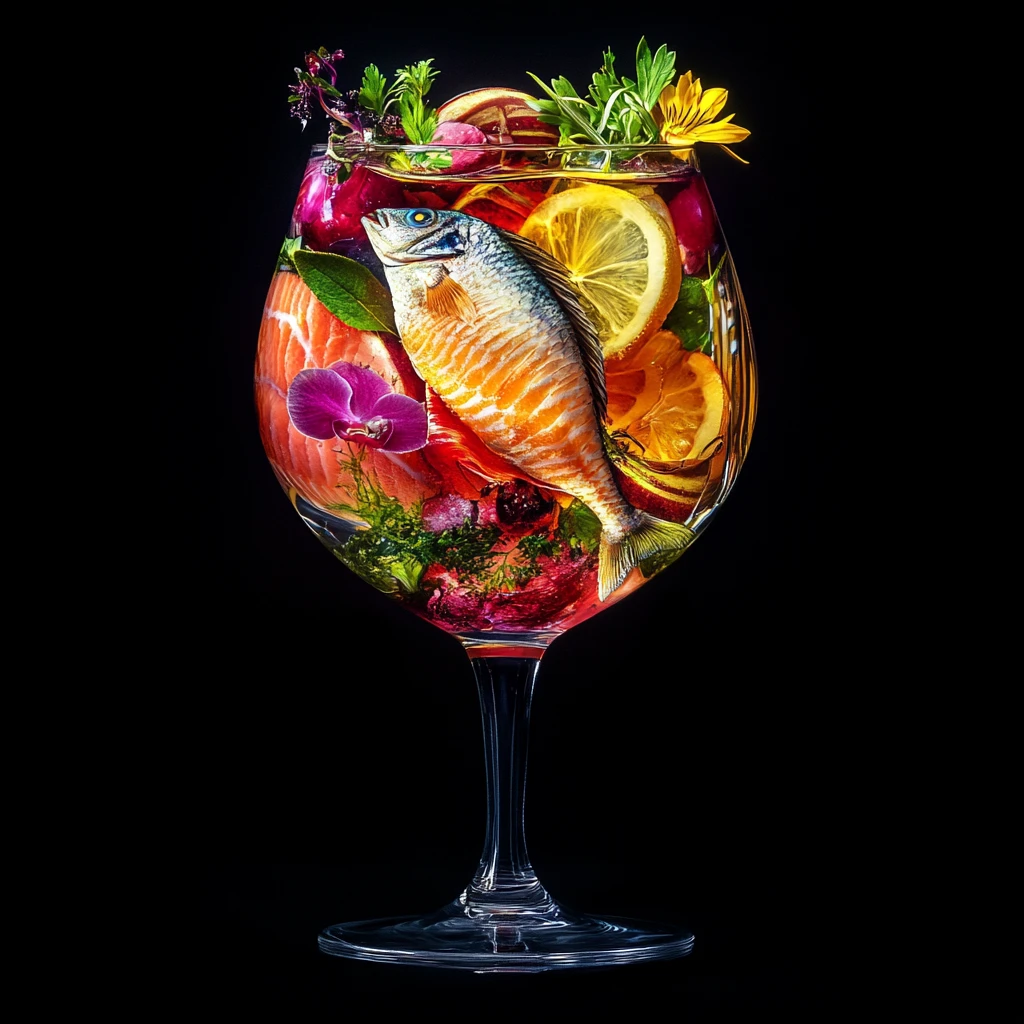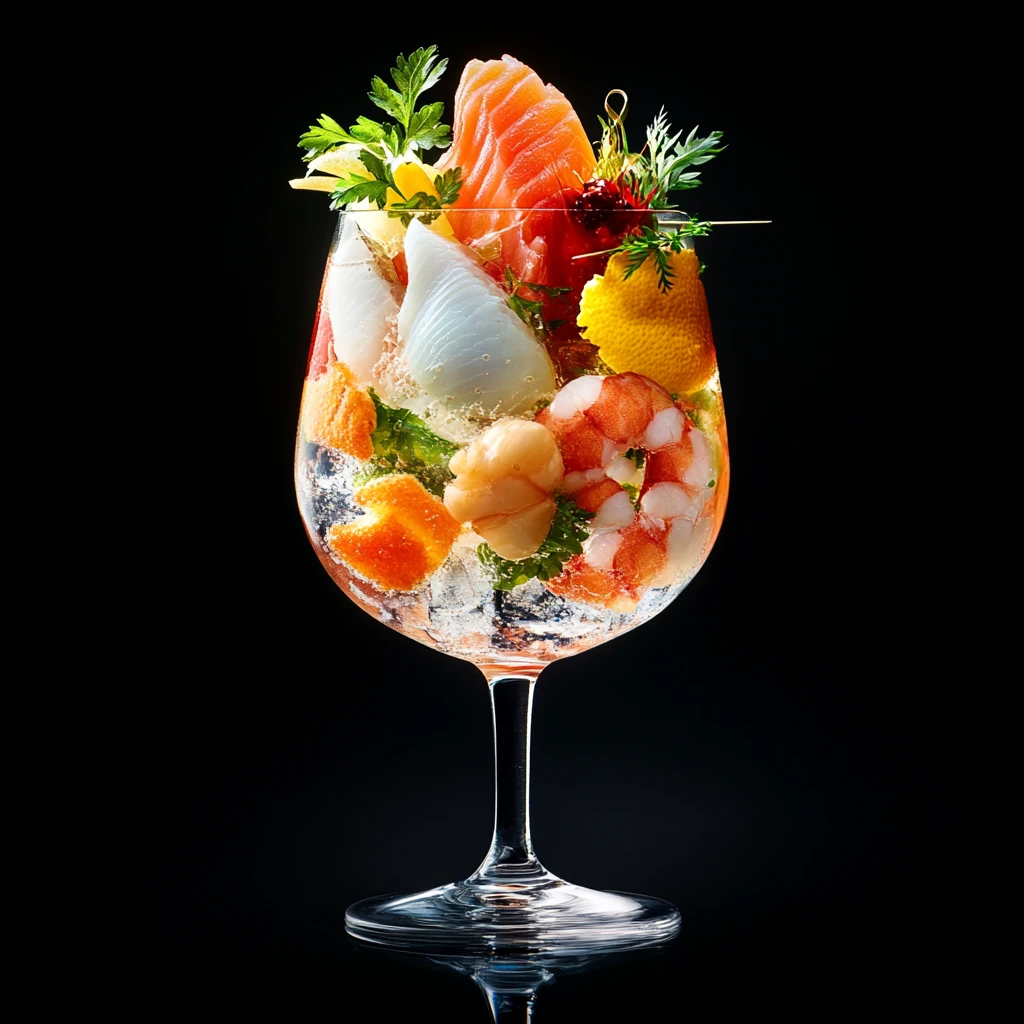Fish Cocktail has long been a culinary delight enjoyed by food enthusiasts around the world. This delectable dish brings together the freshness of fish coupled with an array of sauces and garnishes, creating a sophisticated yet approachable meal that can elevate any dining experience. In this comprehensive guide, we will delve into the myriad aspects of fish cocktails, from their origins to modern variations, ensuring that you are well-equipped to create your own exquisite versions at home.
Understanding the Fish Cocktail Landscape
To truly appreciate the art of the fish cocktail, it’s essential to understand its diverse landscape. From its global variations to the key ingredients that define it, every region offers a unique perspective on this classic dish.
Defining the Fish Cocktail: A global perspective on variations and regional styles
A fish cocktail can take many forms, and what makes it fascinating is how different cultures interpret this concept. For many, a traditional fish cocktail begins with fresh seafood, particularly fish, which is then paired with various sauces and garnishes to enhance its flavor profile.
In Latin American cuisine, for instance, you might find “ceviche,” where fresh fish is marinated in citrus juices and mixed with vegetables like tomatoes and onions. The acid from the citrus ‘cooks’ the fish, giving it a vibrant flavor that’s refreshing and light. Meanwhile, in Mediterranean cultures, the fish cocktail often incorporates olives, capers, and olive oil, presenting a rich blend of flavors that speaks to the region’s love for seafood.
Asian interpretations can be equally creative, utilizing ingredients like soy sauce, sesame oil, and ginger to build layers of flavor while complementing the natural taste of the fish. Each of these approaches demonstrates just how versatile fish cocktails can be, making them a beloved dish across continents.

Key Ingredients: Exploring the types of fish, sauces, and garnishes commonly used
When it comes to crafting the perfect fish cocktail, selecting the right ingredients is paramount. Freshness is non-negotiable; whether you opt for tuna, salmon, or shrimp, the quality of the fish will directly impact the final product.
Classic accompaniments like tartar sauce, cocktail sauce, and salsa verde provide a dynamic contrast to the fish’s natural flavors. However, don’t shy away from experimenting with lesser-known garnishes—think mango salsa or avocado cream—to introduce new dimensions to your dish.
Garnishing can transform a simple fish cocktail into an artistic masterpiece. Microgreens, edible flowers, and finely chopped herbs not only add visual appeal but also elevate the overall flavor, enhancing the dining experience. The right combination can take your fish cocktail from ordinary to extraordinary.
Historical Context: Tracing the evolution of fish cocktails from their origins to modern interpretations
The history of fish cocktails traces back centuries, evolving through various cultural influences. Early references to fish being served with sauces can be found in ancient Roman texts, where seafood was often a centerpiece of banquets. These decadent celebrations paved the way for the introduction of numerous sauces that would later accompany fish.
By the 19th century, fish cocktails gained popularity in Western cuisine, particularly in the United Kingdom and the United States. The rise of canned seafood products during this time made preparing such dishes more accessible, allowing households to enjoy fish cocktails without needing direct access to fresh markets.
Modern interpretations have embraced global influences, incorporating spices, flavors, and techniques from around the world. With the rise of fusion cuisine, chefs continually push boundaries, creating innovative fish cocktail recipes that reflect contemporary tastes while honoring tradition.
Categorizing Fish Cocktails: Differentiating between raw, cooked, and cured preparations
Understanding the different categories of fish cocktails is vital for any aspiring chef. Raw preparations, like ceviche and tartare, celebrate the fresh flavor of seafood, relying heavily on high-quality ingredients and precise techniques to ensure safety and taste.
Cooked fish cocktails, on the other hand, emphasize the use of heat. Poached shrimp cocktails are a classic example, showcasing the sweetness of the seafood complemented by zesty sauces. Cooking methods can vary widely, from grilling to steaming, each imparting distinct textures and flavors.
Cured fish cocktails, such as gravlax or smoked salmon, highlight preservation techniques that bring out the intricate flavors of the fish. The seasoning process enhances the natural taste while adding an element of sophistication, resulting in a luxurious and memorable dish.

Mastering the Techniques
Creating a stellar fish cocktail goes beyond just assembling the ingredients. Mastery of techniques is key to ensuring that the fish shines as the star of the show.
Selecting the Right Fish: Choosing fish based on freshness, texture, and suitability for different preparations
Choosing the right fish is perhaps the most critical step in preparing a fish cocktail. Freshness should always be your top priority—look for clear eyes, shiny skin, and a mild smell. When in doubt, consult your local fishmonger for recommendations, as they can guide you toward the best options based on what’s currently available.
Different fish varieties offer unique textures and flavors. For instance, firm-textured fish like tuna or swordfish work wonderfully in raw preparations due to their ability to hold their shape, while delicate fish like sole or flounder may be better suited for cooked or cured variations.
Consider also the environmental impact of your choices. Opting for sustainably sourced fish not only benefits the ecosystem but also helps ensure the longevity of our oceans’ resources. Familiarize yourself with sustainable fishing practices to make informed decisions that align with your values and support responsible consumption.
Preparation Techniques: Detailed explanations of filleting, dicing, marinating, and cooking methods
Preparation techniques are integral to achieving a successful fish cocktail. Filleting fish requires precision and confidence; mastering this skill will allow you to create beautifully portioned pieces that serve as the foundation for your dish. Always use a sharp knife, and pay attention to the curvature of the fish to avoid wasting any flesh.
Dicing fish for raw preparations involves cutting it into small, uniform pieces. This ensures even marinating and allows flavors to penetrate effectively. Marination is an art form in itself—balance is key, especially when using acidic components like citrus juice, which can easily overpower the fish if left too long.
For cooked fish cocktails, familiarize yourself with various cooking methods. Poaching is one of the gentlest techniques, preserving moisture and subtle flavors. Grilling imparts delicious charred notes, while sautéing offers a quick and flavorful option. Experimentation is encouraged; understanding how different techniques affect the flavor and texture of the fish will elevate your culinary repertoire.
Sauce Selection and Creation: Guidance on preparing classic and innovative sauces to complement various fish
Sauces can make or break a fish cocktail. Classic choices like cocktail sauce, remoulade, and aioli provide a solid foundation, but don’t hesitate to innovate and craft new combinations that enhance the primary flavors of the fish.
A homemade lemon-dill sauce can add brightness, while a spicy mango salsa can introduce an exciting twist. The balance of acidity, sweetness, and spice is crucial—ensure that your sauce complements rather than overwhelms the delicate taste of the fish.
Additionally, consider the viscosity of your sauce. A thinner sauce might work well for dipping, while thicker sauces can coat the fish elegantly, creating a more cohesive dish. Don’t forget to taste-test along the way; adjustments can make all the difference in achieving the ideal flavor profile.

Presentation and Garnishing: Elevate your fish cocktail with expert plating and visually appealing garnish suggestions
Presentation is an essential aspect of serving fish cocktails. Beautiful plating not only excites the eye but also heightens anticipation before the first bite. Start by considering your plate choice—white dishes tend to provide a clean canvas that allows the colors of your dish to stand out.
Layer your ingredients thoughtfully, using height and symmetry to create visual interest. Consider arranging fish in a circular pattern or stacking elements for added depth. Garnishing should enhance the overall presentation—fresh herbs, citrus wedges, or edible flowers can add a vibrant touch that draws the eye.
Remember that our senses play a significant role in our overall dining experience. The aroma of the dish, the colors on the plate, and the textures involved contribute to the anticipation and enjoyment of the fish cocktail. Pay attention to every detail, and you’ll create a dish that delights not only the palate but also the senses.
Recipes and Variations
Armed with knowledge about the essentials of fish cocktails and the techniques required, let’s explore specific recipes and variations that will inspire your culinary journey in this delightful realm.
Classic Fish Cocktail Recipe: A step-by-step guide to a traditional recipe, emphasizing precision and quality
A classic fish cocktail recipe embodies the spirit of simplicity while highlighting the freshness of the ingredients.
Begin by selecting high-quality shrimp, usually peeled and deveined, and add them to a pot of gently simmering water seasoned with salt and a splash of lemon juice. Cook the shrimp until they turn pink and opaque, usually around three minutes. Remove them from the heat and transfer them to an ice bath to stop the cooking process.
While the shrimp cool, mix together your cocktail sauce using ketchup, horseradish, lemon juice, Worcestershire sauce, and a pinch of salt. Adjust the ingredients to suit your personal taste—some may prefer a spicier kick or a tangier finish. Once the shrimp are chilled, arrange them on a platter with a bowl of sauce in the center for dipping.
For garnish, consider adding lemon wedges, fresh parsley, or even cucumber slices for crunch. Serve immediately, and watch as your guests relish every bite of this classic delicacy.
Modern Fish Cocktail Twists: Exploring creative variations using different fish, spices, and presentation methods
Let’s step outside of tradition and embrace creativity with modern fish cocktail twists. Instead of shrimp, try using grilled octopus, marinated in a mixture of olive oil, garlic, and fresh herbs. When ready, pair it with a bright, citrus-based sauce for dipping—perhaps a zesty orange vinaigrette that brings a burst of flavor.
Another imaginative approach involves using sushi-grade tuna for a poke-style fish cocktail. Dice the fish and mix it with soy sauce, sesame oil, diced avocado, and scallions. Present it in an elegant way by layering the mixture atop thinly sliced radishes and drizzling with chili oil for extra heat.
Plating becomes an important part of the process here; think tall and layered rather than flat and spread out. Incorporate colorful elements like pickled vegetables or microgreens to provide contrast and stimulate the senses.
Regional Fish Cocktail Recipes: Showcasing distinctive preparations from various cuisines around the world
Exploring fish cocktails from around the world can open up your palate to incredible flavors. Take, for example, the Peruvian ceviche. Fresh white fish is marinated in lime juice and tossed with red onion, cilantro, and chili peppers. The freshness is unparalleled, and the added crunch of corn or sweet potato brings a fantastic texture to this iconic dish.
Another regional favorite comes from Southeast Asia, known as “yam pla.” By combining poached fish with a spicy salad of lemongrass, mint, and coriander, you create a refreshing and fragrant dish. Drizzle over a dressing made from lime juice, fish sauce, and chili paste for a punchy finish that perfectly balances the delicate flavor of the fish.
These regional interpretations exemplify the versatility of fish cocktails, showcasing how local ingredients and techniques can combine to create something truly special.
Vegetarian/Vegan Adaptations: Creative alternatives using plant-based ingredients to mimic the texture and flavors of fish cocktails
As culinary preferences shift toward plant-based diets, there is ample opportunity to explore vegetarian and vegan adaptations of the classic fish cocktail. For those looking to replicate the texture of fish, consider using roasted cauliflower or marinated tofu. Both ingredients offer a sturdy base that can soak up flavors beautifully.
Create a ‘cocktail’ sauce using cashews blended with lemon juice, dill, and a hint of nutritional yeast for a creamy consistency that mimics traditional sauces. Pair this with your chosen protein, then toss in some fresh herbs and spices for added depth.
Plating can remain similar—present these vibrant ingredients on a clean white plate, garnished with edible flowers or microgreens for an elegant touch. This not only showcases creativity in adapting classic dishes but also promotes inclusivity for those following specific dietary restrictions.
Pairing and Serving
With your fish cocktail prepared, it’s time to consider how to enhance the experience through appropriate pairings and serving techniques.
Beverage Pairings: Suggesting appropriate wines, cocktails, and non-alcoholic drinks that complement the flavors of the fish cocktail
Beverage pairings can significantly elevate the overall dining experience when enjoying a fish cocktail. For lighter dishes, crisp white wines like Sauvignon Blanc or a dry Riesling can beautifully complement the delicate flavors of the fish.
If you prefer cocktails, consider a gin and tonic infused with herbal notes, or a refreshing mojito that will mirror the brightness of the fish preparations. Alternatively, if you’re seeking non-alcoholic beverages, sparkling water with fresh fruit garnishes adds a festive touch without overshadowing the dish.
Experimentation is encouraged here—a fun aspect of pairing is discovering which combinations resonate best with your palate. Providing guests with options allows them to choose the beverage that suits their taste while enhancing the overall enjoyment of the meal.
Side Dishes and Accompaniments: Recommendations for appropriate breads, salads, or other dishes to enhance the overall dining experience
Side dishes play a pivotal role in rounding out the meal. Light salads consisting of mixed greens, cherry tomatoes, and citrus vinaigrette can provide a refreshing contrast to the richness of the fish cocktail.
For a heartier accompaniment, consider serving crusty artisan bread for dipping into sauces or spreads. A side of roasted seasonal vegetables can bring warmth and flavor to the meal.
Finally, don’t overlook the importance of texture. Including crunchy elements like toasted nuts or seeds can add dimension to your plate, engaging diners’ palates in new ways. Thoughtful sides ensure that the focus remains on the fish cocktail while still providing a satisfying and complete meal.
Serving Temperature and Timing: Guidelines for maintaining optimal freshness and flavor during preparation and serving
Timing is everything when it comes to serving fish cocktails. Ideally, prepare all elements close to serving time to maintain utmost freshness. If working with raw preparations, keep the fish chilled until just before assembly to preserve its quality.
For cooked fish cocktails, remember to serve them warm. Allow them to rest slightly after cooking to prevent steam from making them soggy.
Temperature plays a crucial role in flavor perception—cold dishes should be served chilled, while warm dishes should be served hot. Be mindful of timing throughout preparation and service to ensure that every component of your fish cocktail shines at its best, delighting both you and your guests.
Conclusion
This guide provided a comprehensive exploration of the fish cocktail, covering its history, preparation techniques, variations, and serving suggestions. By understanding the fundamentals and applying these techniques, you can create a delightful and sophisticated fish cocktail experience. As you experiment with various ingredients and styles, remember that the true art lies in celebrating the freshness of the fish and the joy of sharing this remarkable dish with others. Let your creativity flourish, and relish every moment spent in the kitchen crafting exquisite fish cocktails that delight the senses.
For more recipes please click on below links:
Dive into Branzino Meat: Explore its Flavor and Culinary Versatility
Easy Eggless Sausage Hashbrown Breakfast Casserole Recipe – Make Mornings Delicious and Hassle-Free

